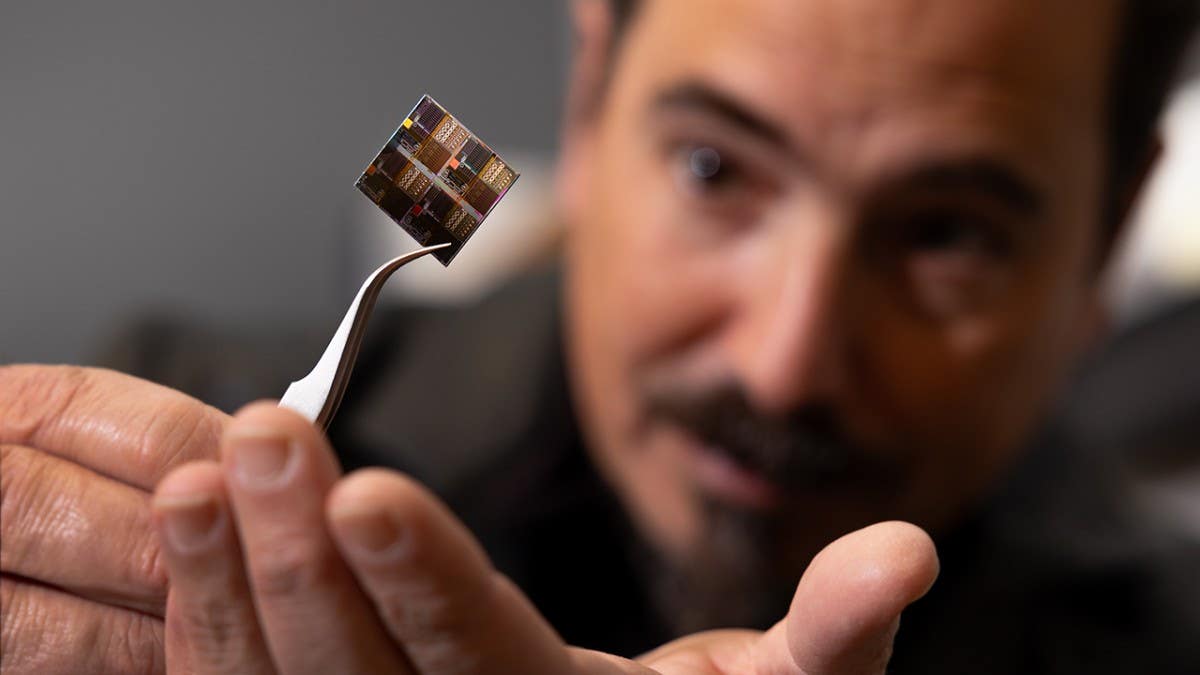Scientists build the world’s tiniest walking robot measuring just 2 microns
Microscopic diffractive robotics merge optics and mobility, revolutionizing imaging, medicine, and materials science.

Itai Cohen, professor of physics, in his lab in the Physical Sciences Building. (CREDIT: Jason Koski/Cornell University)
Microscopic robots are reshaping the boundaries of science and technology. These micrometer-scale machines combine diffractive optics with dynamic robotics, unlocking applications once thought impossible.
By exploiting how light scatters off their tiny surfaces, these robots can manipulate light fields, providing tools for high-resolution imaging, tunable optics, and force sensing at an ultrasmall scale.
Miniaturizing such robots to interact with visible light poses significant fabrication challenges. Defined as micrometer-scale machines equipped with information to enable locomotion, these microbots require innovations in design and material science.
Recent advances have made this leap feasible, creating a foundation for "diffractive robotics"—a novel field where light diffraction meets robotic mobility.
The foundation for diffractive robotics relies on two groundbreaking technologies. The first is a protocol for encoding magnetic information into microscale robots, enabling precise actuation.
The second involves the use of atomic layer deposition (ALD) to fabricate ultrathin, flexible hinges. These 5-nanometer hinges serve as connective tissue for the robots, offering both durability and compatibility with semiconductor manufacturing.
These innovations allowed researchers to encode multi-axis magnetic information into diffractive panels. This capability makes the robots magnetically controllable and flexible enough to reconfigure within millitesla-scale magnetic fields.
The result is a platform that marries robotics with the optical precision required for visible light diffraction.
Tiny Robots, Big Potential
Cornell University researchers have pioneered this field, unveiling the smallest walking robots ever recorded.
Measuring just 2 to 5 microns, these robots are small enough to interact with visible light waves while maintaining independent mobility. They surpass Cornell’s previous record of 40 to 70 microns, with potential applications ranging from biological imaging to force measurement.
“A walking robot that’s small enough to interact with and shape light effectively takes a microscope’s lens and puts it directly into the microworld,” said Paul McEuen, emeritus professor of physical science at Cornell. “It can perform up-close imaging in ways that a regular microscope never could.”
Related Stories
The team’s research, published in Science under the title "Magnetically Programmed Diffractive Robotics," highlights the robots' ability to maneuver through fluids and across solid surfaces.
Their movements, controlled by magnetic fields, resemble a pinching motion, enabling them to inch-worm forward or swim. This versatility ensures they can reach and image intricate biological structures.
The term "diffractive robotics" reflects the groundbreaking integration of untethered robotic movement with light diffraction.
Light waves bend when passing through openings comparable to their wavelength, a phenomenon critical for imaging at micro scales. To achieve this, the robots must be both optically compatible and autonomously mobile—criteria the Cornell team has successfully met.
“These robots are tiny, and we can get them to do whatever we want by controlling the magnetic fields driving their motions,” said Itai Cohen, a professor of physics and co-author of the study. The robots’ ability to interact with light provides unique imaging possibilities, placing the precision of a microscope lens directly at the nanoscale.
Applications and Future Impact
The implications of diffractive robotics span across disciplines. In medicine, these robots could navigate tissues to image cellular structures or measure forces within biological samples. Their ability to manipulate local light fields offers potential for advances in optical devices, enabling real-time adjustments at the nanoscale.
Beyond medical imaging, the robots’ flexibility and maneuverability could benefit industrial applications. Their sub-diffractive optical capabilities may revolutionize materials science, precision manufacturing, and environmental monitoring.
The research owes its progress to the Cornell Center for Materials Research, the National Science Foundation, and the Cornell NanoScale Science and Technology Facility. These institutions provided critical resources, highlighting the collaborative effort behind these innovations.
Diffractive robotics marks a new era in both robotics and optics. By shrinking robots to sizes that interact with visible light, scientists have created tools that can explore realms previously inaccessible. This fusion of mobility, flexibility, and optical precision offers a glimpse into the future of technology at microscopic scales.
The work at Cornell demonstrates how combining magnetic actuation with advanced materials can create versatile, tiny machines. As the field evolves, the potential for these robots to reshape science, medicine, and industry is immense.
Note: Materials provided above by The Brighter Side of News. Content may be edited for style and length.
Like these kind of feel good stories? Get The Brighter Side of News' newsletter.
Rebecca Shavit
Science & Technology Journalist | Innovation Storyteller
Based in Los Angeles, Rebecca Shavit is a dedicated science and technology journalist who writes for The Brighter Side of News, an online publication committed to highlighting positive and transformative stories from around the world. With a passion for uncovering groundbreaking discoveries and innovations, she brings to light the scientific advancements shaping a better future. Her reporting spans a wide range of topics, from cutting-edge medical breakthroughs and artificial intelligence to green technology and space exploration. With a keen ability to translate complex concepts into engaging and accessible stories, she makes science and innovation relatable to a broad audience.



